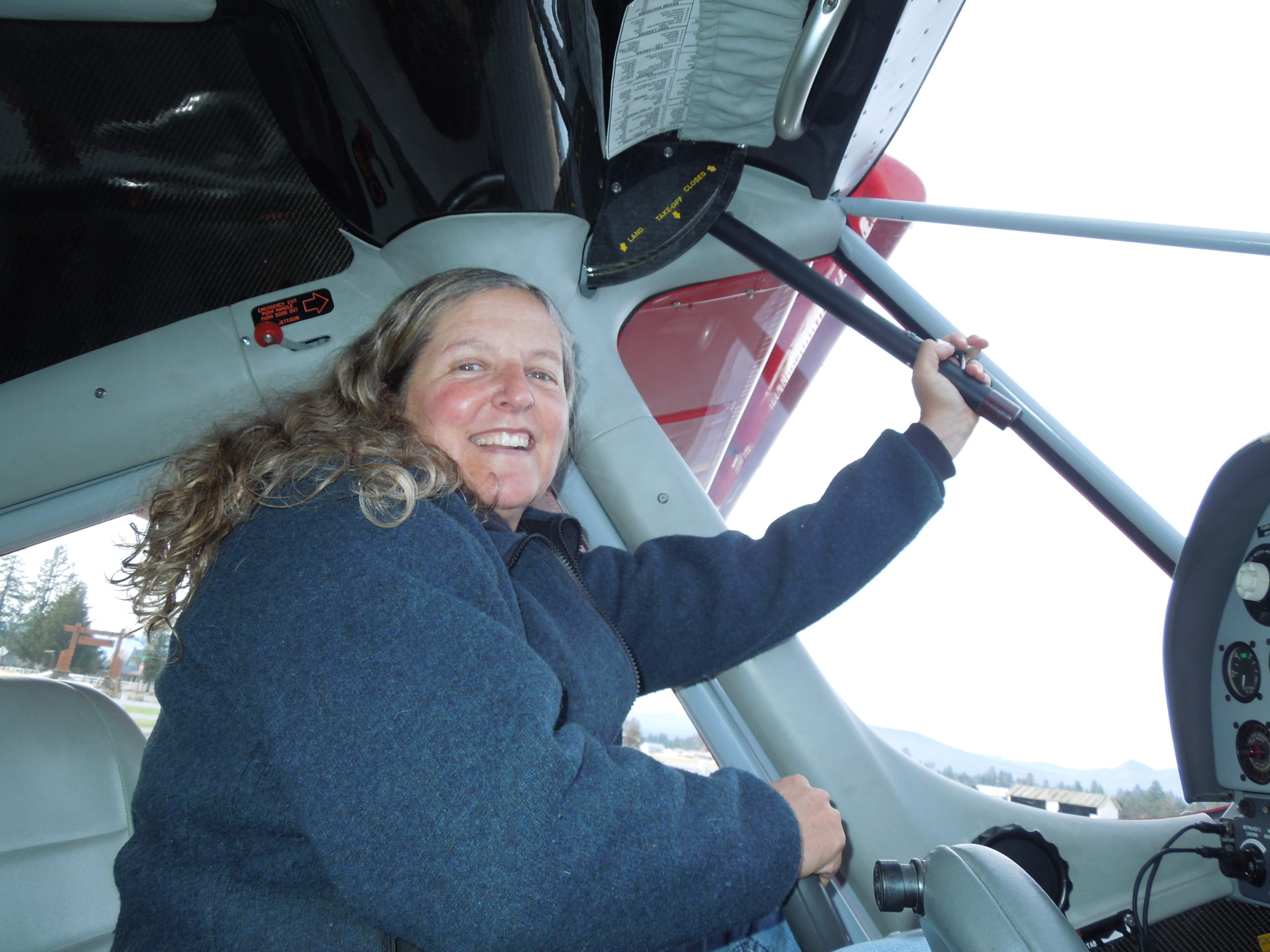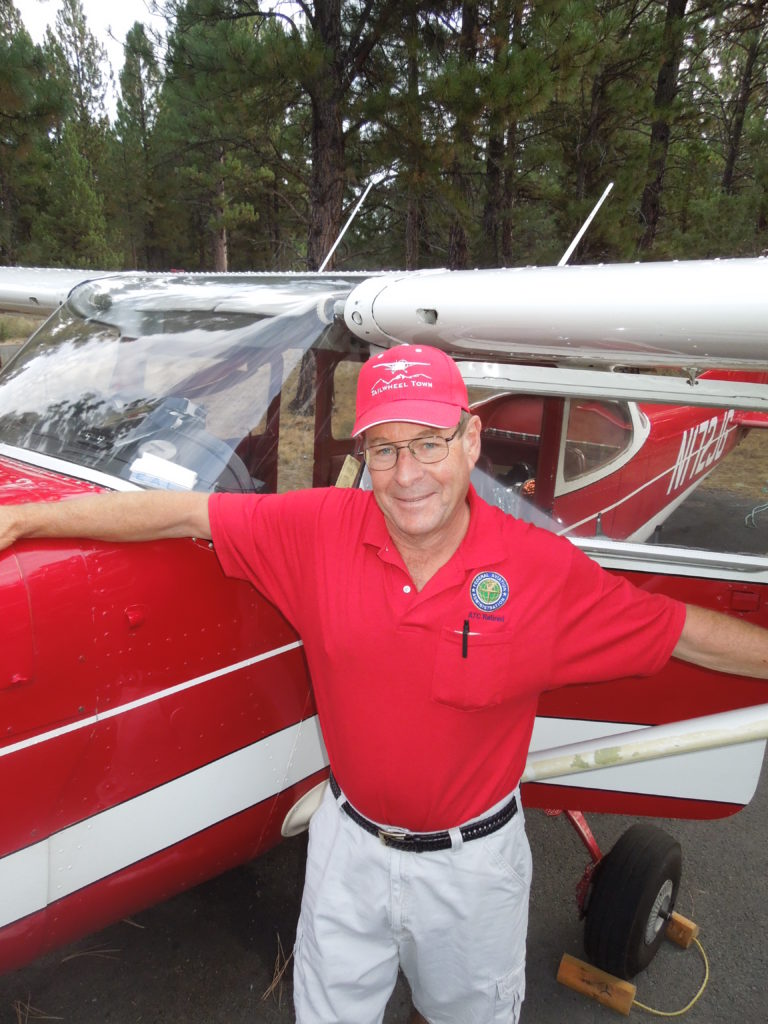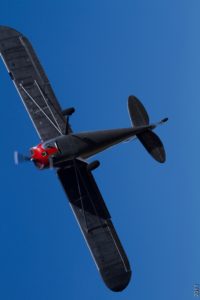(I’ve been sitting on this one, but probably started it in 2015)
I guess if I have a favorite aviation iconic phrase to “clast”, it would be that old wheeze, “the key to a good landing is a good approach”. I feel that all too often that kind of thinking becomes a refuge for the undertrained. As all who have flown with me know, I think we all need to make good landings out of ANY kind of approach.
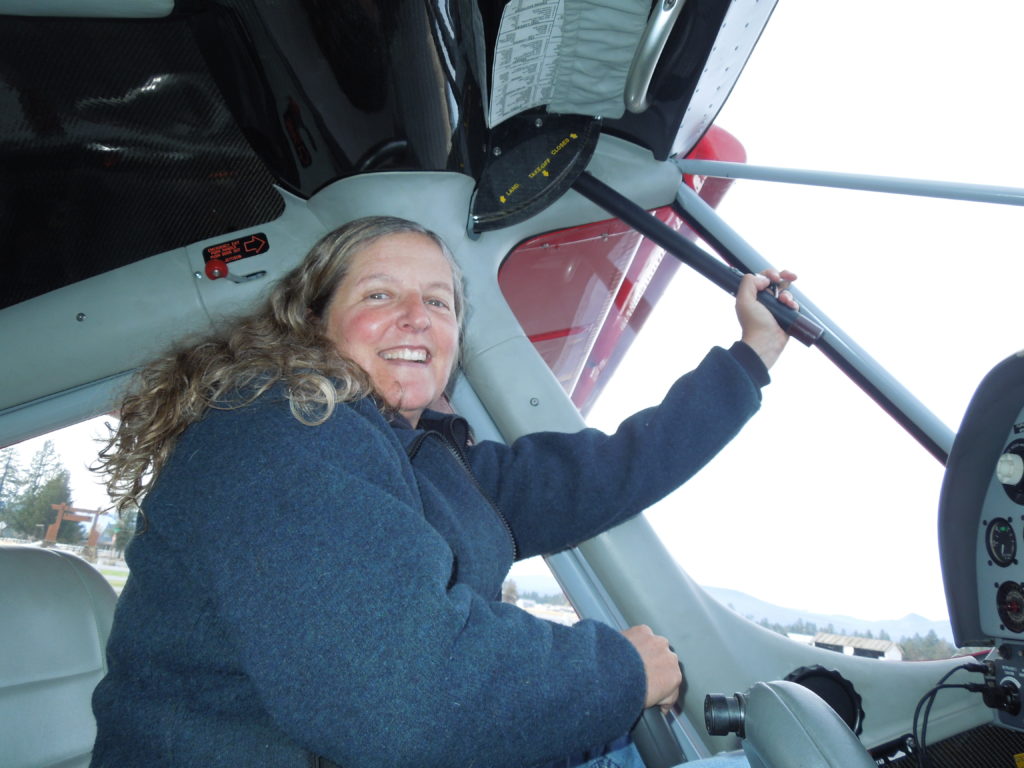
Julie Benson operates the flaps on a Polish Wilga. Flap handles vary widely and can be important considerations. |
Incremental flap extension is, in my opinion, a method that encourages minimal training. (Here come the villagers with their torches and pitchforks!). Incremental flap extension is the popularly taught method calling for a few degrees on downwind, a few more on base and a few more on final. This technique requires little re-trimming or adjustment of pitch because the changes are relatively small. If you were to extend all your “flappage” at one time you would have a relatively large pitch and trim change (depending on the particular aircraft) in order to maintain the desired angle of attack and airspeed. Such a technique would require greater skill and/or practice on the part of the pilot. That’s why I teach it.
Let’s review the purpose of flaps (you know how I love fundamentals): Flaps perform three basic functions:
When we extend them, they slow us down, which can be useful, considering that we are getting ready to land and every airplane should be landed just as slowly as it can go.
Flaps generate drag which decreases our glide efficiency, and this is one reason that I question the normal extension technique. That drag allows us to fly a steeper approach without increasing airspeed. This enables us to arrive on the runway with more of it in front of us if we have to clear an obstacle on the approach. The same drag which enables us to fly a steeper approach, clearing an obstacle, also makes it possible for us to vary our touchdown point. We could just shove the nose down to steepen that approach. We would arrive at the same spot, but we’d be flying faster and would have to wait for that speed to decay during the flare, thus resulting in a touchdown further down the runway. That would be particularly true in a nosewheel airplane which MUST be allowed to stall down on the runway. A tailwheel airplane can be “wheel landed” at a higher speed, then braked, if necessary.
Flaps also decrease the stall speed, enabling us to land at a slower speed. This results in a shorter landing and perhaps less brake and tire wear. A reason for extending flaps on short final, which I prefer, is that we normally fly slower with flaps extended than we do with them retracted and I’d like to see our speed higher as long as possible, thereby getting us to our destination a little faster (this is not a big issue, but more a matter of personal principle).
Flaps COULD serve to increase our spot landing accuracy if we used them like we use spoilers/dive brakes in a glider. The normal technique for accuracy landing in a glider is to extend some of the spoilers on downwind. Many pilots like 1/3 spoilers. Then the approach is flown as accurately as possible. Once at the “key” position after the turn to base the pilot analyzes his glide. If the approach looks short, the pilot closes some spoilers, thereby increasing lift and decreasing drag. The touchdown or flare points then move further away. If the target appears to be too far down the runway, the pilot simply applies more spoilers, thus steepening the approach course and moving the target closer. We could use flaps the same way, but most pilots are taught to never retract flaps except carefully on a go around with full power. The reason for this conventional wisdom is that flap retraction will result in increased sink because of the loss of lift. It’s worth it to do some experimentation on power-off flap retraction. The main difference between flaps and spoilers/dive brakes is that flaps increase lift, while the combination found on gliders only increases drag while DECREASING lift. That’s why students are discouraged from decreasing flaps while at low altitude…such an action CAN decrease lift. However, some of the same techniques that are used with gliders can be used. Obviously, all aircraft don’t have the same flaps. The cute little flaps on the Cessna 140 are more symbolic than effective. Retraction of those flaps on approach won’t hurt much. The big ol’ flaps on a newer Cessna are an entirely different story. For some thoughts on the use of flaps like that, I turned to one of my favorite consultants, Jerry Groendyke:
Jerry has played with retracting flaps on final in his 172, a technique that horrifies some who’ve never experimented with it. The 172’s 40-degree flaps are quite effective. Jerry’s been known to have a bet riding on making a spot landing and intentionally putting in too much flap. The other person is sure he’s screwed up and is already counting his winnings. But then, when Jerry retracts some flaps, it feels like power has been added. His opponent will usually object with “that’s not fair, that’s cheating, that’s dangerous, bet’s off, etc, etc, etc…”
Jerry Groendyke |
Jerry feels that, as a rule, in the small aircraft we fly, flaps should not be extended if the power is above idle. I couldn’t agree more with just a few exceptions, like the power-off accuracy approach. The sequence should be: power to idle, speed controlled by pitch, then lastly flaps. Most of my students are familiar with my routine. When they turn base I ask them if they are high or low. If they are really high, I’ll advise them to put the flaps down right then and there. In that case it’s a coarse adjustment for a really high approach. But if they’ve done a good job of designing an accurate approach and are in the middle of their glide range they won’t need to add flaps until short final.
There’s more conventional “wisdom” to debunk when it comes to crosswind landings. The last-minute slip technique is used, as it should always be by competent pilots carrying passengers. Jerry likes to land in a crosswind with as much flappage as possible. Remember he’s flying a tricycle gear airplane. We’ll get to the tailwheel shortly. He’s still able to maintain runway alignment by crabbing. That’s easy. The common thinking seems to be land fast with little to no flaps and fly the airplane onto the ground then try to keep it straight as it becomes a ground vehicle. But the problem is that area between fast enough to fly, and slow enough to be controllable with steering and brakes. Jerry and I both prefer as much flaps as possible. That allows us to go as slow as possible. We crab, which so far is no problem regardless of wind strength. It also keeps our passengers comfortable. Then at the last second, and about a foot or so up, we side slip to put our upwind wheel on the ground (this is where you will find out if this speed and flap combination will work, sometimes you may need to try again with less flaps and more speed for rudder to be effective) while simultaneously raising flaps. Manual flaps are best of course, and for electric flaps you may need a third hand to raise the flaps when you say so (this is where I dearly love Cessna’s “set ‘em and forget ‘em” electric flaps).
The subject of crab-to-slip is possibly the most over-discussed subject in the airport bar. I refuse to participate in that discussion. It’s just too basic. Let’s skip that old wheeze and discuss something that I think is really important and difficult. That’s the proper retraction of flaps.
If you can be near flaps down stall speed, at a very slow ground speed due to a strong wind, as soon as you touch and raise the flaps you will quickly be below flaps up stall speed, weight is on gear, brakes work, and steering works.
As of this writing, one of my primaries is now practicing the fine art of raising her flaps in the middle of the flair. I love this technique, but it does require skill and practice. The benefits of it should be obvious.
In a tailwheel airplane crosswind technique can actually be easier. I guess it depends on what you’re used to. Using the same general technique but perhaps carrying just a little more speed, you touch down in a wheel landing, planting the mains on the ground and raising the tail so that there is zero angle of attack. That accomplishes the same thing as Jerry’s flap retraction and subsequent stall. You’ll still be above stall speed but when you can no longer keep your tail up you should be below stall speed. You, too will have brake effectiveness which, combined with decreasing rudder but increasing tailwheel steering will more than equal the trike’s nose wheel steering. I should point out that I still like Jerry’s technique of flap retraction during the flare. For one thing, if flaps increase the ship’s weathervaning tendency, they only do so when the wheels are on the ground, so flap retraction will minimize that effect. Many pilots, especially those in high wings, land fast in a crosswind with no flaps, and spend a lot of distance swerving back and forth and sometimes run off the runway because they are just barely touching the ground.
Until modern flight training becomes more sensible (which is very unlikely), there will continue to be improper flap usage. Here’s a great example:
There was once a pilot inbound to an airport in Florida from the Bahamas in a C172. He was very low on fuel and reported that fact to the tower. The wind was from the northwest at 30 or so knots, so he had a direct headwind. He was cleared to land straight in on 32. About two miles out, the pilot was observed lowering his flaps. That was probably how he was taught at Acme. To many of us, that would be like putting your car’s parking brake on when you’re trying to make it to the gas station on fumes.
And if you ever take one of my courses, ask me to demonstrate the only time that flaps can be used to actually extend the glide. It can be tricky, but with practice at the power- off approach, we can terminate that approach just short of the touchdown point. So, the objective must be to slightly extend the airplane’s glide, so that it “makes it”. And we must do that without adding any power. How do we do it? By the very surprising use of flaps. But only if we’ve resisted the temptation to extend them before reaching ground effect on short, short final. Because, you see, if you’ve glided to that point and still have not extended your flaps, by extending them now, you will increase lift, and taken advantage of ground effect to extend that glide. It’s a beautiful thing to behold and it is the most efficient use of flaps that I can imagine. It takes practice, just like every difficult maneuver we practice at Tailwheel Town. But it does prove the point that holding off on flap extension will avoid the drag they produce, thus extending your glide and also providing lift at the last possible moment, thereby extending the airplane’s glide. This maneuver also proves that extension of flaps early in the approach, like on downwind or even base, is often wasteful and (with apologies to all those Acme instructors) … “ill- advised”. (See how I adroitly avoided insulting a whole bunch of instructors by calling it “stupid”?) I should point out that I have NEVER met a pilot who uses this technique! Most “Acme” instructors have never heard of it and are slaves to the incremental flap extension that is taught at Acme. I’ve also found that virtually everyone I’ve ever flown with wants to apply a bit of power if they are short. They don’t need to. They could simply extend flappage and thus extend the glide. But they won’t, because they’ve always done it that way!
Let’s now talk about the device which we use to operate the flaps. It can be important. Many airplanes, especially older ones, use a “Johnson Bar”. I guess Johnson was an engineer or something. I love this one. You simply reach down and grab that bar, then pull it up and feel it click for each increment of flaps. To retract the flaps, you simply put a little tension on the bar, push the button on the end and lower it to the floor. Aerodynamics will be glad to help retract the flaps. I love this method of flap retraction, although you may be pretty busy using it if employing our crosswind, sudden-flap-retraction technique. I should point out that the same system is used in our little Cessna 140 as is used in the larger Cessna 180 and 185. Although they operate the same way, they are worlds apart in ease of operation. It takes some practice to smoothly or quickly use the larger Cessna’s Johnson bar. One of my most talented fliers, who is very experienced, simply won’t’ deal with flaring flap retraction in his Cessna 180 because of the need to lean so far forward. I trust his judgment.
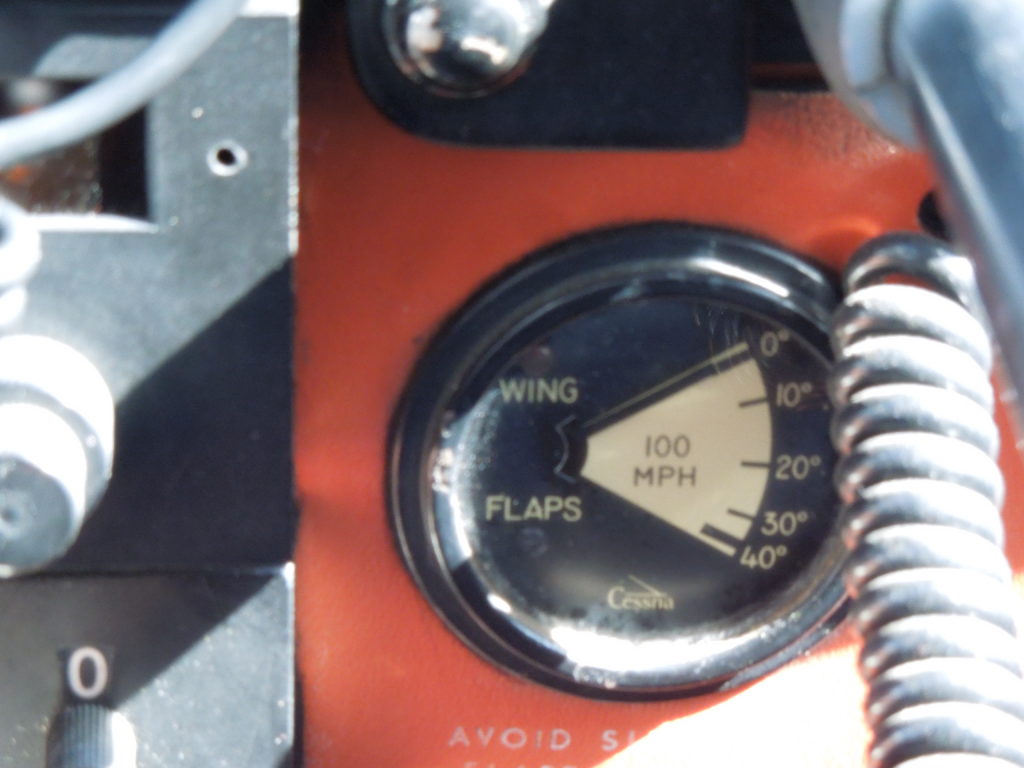
The flap position indicator on an early Cessna |

